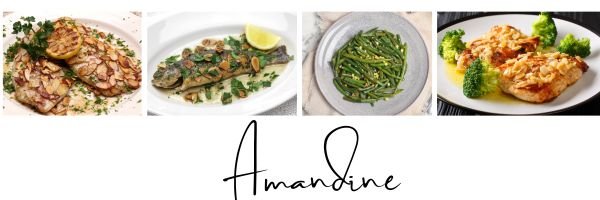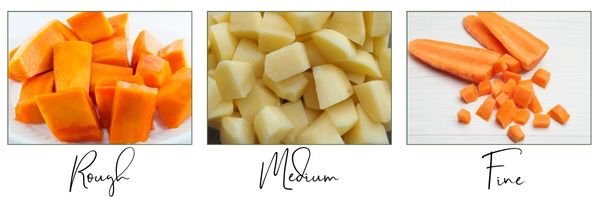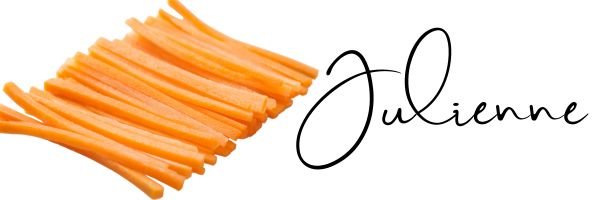CULINARY VOCABULARY
Here is your ULTIMATE guide to Culinary Vocabulary! If you are on a laptop or desktop, press crtl f and you will be able to search for the the word you need! If you don’t see the word you’re looking for, let me know by reaching out on my contact page.
A La: Meaning “according to” or “in the manner of”. In cooking it’s referring to a certain way of preparing a dish.
A La Carte: According to menu. This is when you order items individually as opposed to a fixed meal.
A La King: Meaning “in kingly style” and also means served in a cream sauce. Chicken A La King means chicken served in a cream sauce. It commonly will have mushrooms and green peppers or pimiento. So you’re getting a cream sauce fit for a King!
A La Mode: This is one of my favorites! It translates to “according to the fashion”. In culinary terms its when you top something with ice cream! I don’t know about you, but I find ice cream very fashionable.
Acidify: When you are acidifying a dish, you are increasing the sourness or acidic content. Some common acidic foods are citrus fruits, pineapples and vinegar (specifically red wine vinegar). The juices from cranberries, blueberries and pomegranates can add a tart flavor that can add an acidic balance if you don’t have citrus fruits, pineapple or vinegar.
Aging: Letting certain food products sit for an extended period of time. For example, cheese, is left for various amounts of time to develop certain flavors. Swiss cheese is usually left to age anywhere from six to 14 months. Parmesan cheese is left to age from 10 to 24 months! Meat, wine and balsamic vinegar are also made better by aging.
Al Dente: An Italian term that describes a consistency that pasta and/or rice should be cooked to in order to be perfectly cooked. Al dente pasta is cooked to a tender but firm consistency. It will have a bit of a ‘bite’ to it but still be easy to chew and soft. The cooking time is usually 1-3 minutes less than what is quoted on the package directions.
Al Forno: Describes food cooked in an oven. You’ll see this term most often in Italian dishes like lasagna, ziti and pizza.
Al Fresco: This actually doesn’t always apply to food specifically. Al Fresco means ‘outdoor, outdoors’. If a restaurant is offering something Al Fresco, it means that the food will be enjoyed outdoors. It’s called dining alfresco!
Amandine: You’ll hear the phrase ‘Trout Amandine’ and it means trout garnished with almonds! This is a fancy term for a very simple way to prepare food and bring a bland dish up a notch.
Aioli: This is one of my most favorite sauces! Aioli is a tangy, zingy, creamy sauce most often made with olive oil, mustard, garlic, egg and lemon juice. Some people think that mayo and aioli are the same, but that is not true. They are similar textures, but mayo is made primarily with egg yolks and vegetable oil. Its a more mild flavor. Aioli is made with egg yolks, olive oil, lemon juice, garlic and salt. Aioli is used mostly with seafood, veggies and breads. Mayo is used more with hamburgers, salads and sandwiches.
Appetizer: This is something that arouses or increases anticipation for what is to follow. So, an appetizer is a small dish of food designed to increase excitement and anticipation for the main dish.
Asada: Translates to ‘roasted'. Carne Asada is spicy marinated roasted beef, Asada is simply roasted meat cut into strips.
Asado: You’ll hear this most often in the phrase ‘pollo asado’. Pollo (pronounced poy-o) means ‘chicken’. Pollo Asado is grilled marinated chicken.
Au Bain-Marie: This is referring to a water bath. You may see this term in canning. When you place a pot or container of food inside another container filled with water, you are using the Au Baine-Marie method.
Au Gratin: Au Gratin is a French term describing a dish that is covered with cheese and/or breadcrumbs and then browned under a broiler or in an oven.
Au Jus: I am a huge Au Jus fan! This is a French phrase that means ‘with juice’. Au Jus is a gravy or broth made with the juices from cooked meat. Its most commonly seen in the USA with a beef and provolone toasted sandwich. You may also see it served to enhance the flavor of veal, lamb and chicken.
Baster: A large tapered tube with a large rubber bulb used to gather juices and moisten food while its cooking. This is most commonly done with roasts, chickens and turkeys.
Basting: A cooking technique used to keep food moist by periodically applying its own juices or marinade. This is typically done with a baster, which draws the liquid and gently releases it back over the food during cooking.
Blanch: This is when fruits and/or vegetables are submerged in boiling water for 2-3 minutes, then immediately cooled either with an ice bath or running cold water over the food. This is most commonly done during food preservation. This technique is used to help peel fruit or stop an enzymatic action.
Braise: Slowly cooking of meat and/or vegetables in a small amount of liquid with slow rising heat. The food must be tightly secured in the cooking vessel. Braising is different from stewing because the food is not fully submerged in water during the cooking process.
Brine: A salt and water solution used to soak meats in to enhance flavor, moisture and texture of the meat.
Brining: A cooking technique where meat is soaked in a brine for at least 12 hours to enhance flavor. This is a common techinque used for cooking turkeys.
Butterflying: A cutting technique done to meat during the preparation phase. The meat will usually be boneless, flattened and nearly cut in half, but not all the way. When the meat is laid out it will resemble butterfly wings.
Caramelize: The process of heating sugar at a high temperature until the water is removed and sugar is broken down, resulting in a sweet, buttery, nutty flavor.
Capers: Unripe flower buds from a caper bush. They are picked, dried and pickled. The flavor is similar to a green olive, HOWEVER, they do not have the bitter bite that green olives do. These have a floral tart, salty flavor that some have described as slightly sweet.
Char: When the surface of food is lightly burned to add flavor. You will see this most often on kabobs or on the edges of meat that are cooked on a grill.
Chiffonade: This is a French cooking technique for cutting leafy greens and herbs in very fine, thin ribbons. The easiest way to Chiffonade is to stack a few leaves together, roll tightly and then slice in to thin strips.
Chop: Chopping is a basic technique for cutting food into bite sized pieces. Below is a breakdown of the chopping variations and the rough dimensions.
Rough Chop: Large chunks about 3/4 inch.
Medium Chop: Chunks should be about 1/2 inch.
Fine Chop: Chunks should be around 1/4 inch.
Clarify: Removes particles and/or cloudiness from liquids, making it a crisp and clear liquid. This is most commonly done with meat broths, butter and egg whites.
Confit: This technique involves slowly cooking a food in fat or liquid (seasoned). When you store the food, you would store it in the same liquid that it was cooked in. This helps preserve the food and maintain an excellent flavor.
Crème Fraiche: Oh this is a tasty one! Crème Fraiche is a delicious thick, tangy, rich cultured cream. It literally translates as ‘fresh cream’. This can be used in sweet or savory dishes.
Crimp: Crimping is the way you decorate/pinch the edges of a pie to seal the crust.
Cure/Curing: This is an excellent way to preserve meat. Curing is adding in salt, sodium, nitrites, sugar or seasonings. This process can take anywhere from a few days to a few months.
Dash: “A dash of this and a pinch of that”. A dash is a unit of measurement that isn’t really a unit of measurement. hehehe. I like to explain a dash as one shake of a salt shaker. That motion you make should give you about what a dash is expected to be.
Deglaze: If you’re an Instant Pot user, you know this phrase. Deglazing is when you add liquid to a hot pan to loosen burned or stuck food bits. I like to use a wooden spatula and I start scraping the bottom as soon as the liquid is in the pan.
Degrease: The process of removing fat content. This could be something as simple as skimming the top of some soup with a spoon to remove the floating fat or, using a strainer to separate meat from the grease.
Dehydrate: This is the process of removing water from food to help preserve the food. You’ll see lots of dehydrated fruits and some vegetables. Some of my favorites are dehydrated mangos and cranberries!
Dice: A basic technique for cutting up foods into pieces about 1/8 inch pieces. The images below should help you get a good idea of what the average dice job looks like.
Dollop: A small amount of soft or sticky food. If I am needing a dollop of sour cream, I will take a large cereal spoon and get a small heaping scoop. Its like the scoop of sour cream on chili or whipped cream on pumpkin pie.
Dry Rub: This is a hearty blend of spices liberally rubbed all over the surface of the food you are about to cook. I have done dry rubs on beef, steak, chicken and pork roast.
Duxelles: A mince of herbs, onions, mushrooms and black pepper sautéed in butter then reduced down to a paste. You’ll see this as a filling, a garnish or in some cases a condiment.
Effiler: The removing of the string from a string bean OR to thinly slice almonds.
Egg Wash: A beaten egg (both the yolk and egg white) brushed over a pastry before baking. Its also a yummy way to seal in flavor in fish.
Emulsify: Is the combination of two or more liquids that don’t usually mix together easily, like oil and water. Its emulsified together when its all combined. Oil and vinegar salad dressing is an excellent example. If let out to sit, the oil and vinegar and seasonings all separate. When shaken or stirred vigorously, they blend into a delicious dressing.
En Croute: This technique is where you wrap meat in a pastry before cooking. A popular example is Beef Wellington!
En Papillote: A method of quick steam cooking. This method uses parchment paper (foil can be used as a substitute) folded together creating an air tight package. This cooks the food in its own juices. Who knew that a campfire hobo dinner can also be called En Papillote (pap + i + loht).
Fermentation: The chemical breakdown process of a substance with yeast, bacteria or other microorganisms. Examples of foods that go through the fermentation process are; liquor, cheese, yogurt, kombucha, pickles, sauerkraut, apple cider vinegar, vanilla, sourdough bread and more!
Fillet: A boneless cut of meat or fish. Fish fillets are sliced parallel to the spine as opposed to perpendicular. There are many different cuts of meat that can be done to get a fillet. Some of those are; cutlet, ‘j’ cut, fletch, and single.
Flambé: This is a cooking procedure where alcohol is added to a very hot pan creating a burst of flames. It’s is a French word that when translated means “flamed”. You’ll see this in table presentations with foods or desserts that are liquor drenched. My favorite example is Bananas Foster…. Its fun to watch and absolutely delicious!
Florentine: Dishes that are prepared atop of bed of spinach or with spinach incorporated in the dish.
Folding: A technique used to blend light density foods with higher density foods. This is also a technique used to add ingredients gently and efficiently into a mixture. I use this method as much as I can, because its also a way to combine ingredients and keep the mixture in the bowl. Sometimes regular stirring gets messy. Below is a video demonstration.
Fumet: A concentrated stock from meat or fish and it is used for flavoring.
Ganache: This is a smooth rich chocolate filling or glaze/frosting. Its made from shortening, chocolate and cream.
Garlic Press: A tool used to quickly and easily mince garlic.
Garnish: Decorative items, herbs, cheeses, spices or other substance used to amplify a dish. It can be something that alters the taste or enhances the colors.
Gastrique: A delectable French sweet and sour sauce made by caramelizing sugar, then adding vinegar or other sour liquid. Gastrique is often enhanced with fresh fruit, butter or herbs.
Gelatin: This is a thickener used most often in jello and jam. Gelatin is pure protein from beef bone and veal bone byproducts. Its colorless and odorless.
Ghee: A form of clarified butter that has been simmered down until all moisture has evaporated and it starts to brown. This gives it a nice nutty and caramel flavor and scent. Ghee lasts longer than regular butter and has a higher head threshold/smoke point.
Glaze: Shiny, clear coating most often found on desserts and pastries. You may also see it on different meats, like ham. You may have heard the term ‘egg wash’. This is where you beat a raw egg and brush it over savory bread items like bread or pretzels. This is also considered a glaze.
Gnocchi: Pronounced “nyo-kee”, this is one of my most favorite starchy foods! This is an Italian dumpling made from potatoes! There are other creative variations that can be made from a variety of items. There is also a pasta that is similar shaped, also named Gnocchi.
Grater: This tool is used to quickly shred foods like cheese, potatoes, carrots, onions, etc. There are many variations!
Hibachi: A Japanese term for grilling on high heat with a sheet of metal or metal plate over charcoal or wood. There are restaurants that are specifically for Hibachi grilling! Its a wonderful and fun experience!
Hoisin Sauce: A sweet, tangy, thick, savory sauce often used in Asian cuisine. It can be used for dipping, glaze on BBQ’d meat. This is an excellent addition to chow mein, stir fry, dumplings, spring rolls and more!
Hollandaise Sauce: A delicious creamy sauce made with melted butter, egg yolks and lemon juice. This is most often used in dishes like omelets, eggs benedict, asparagus, fish, brussel sprouts and other vegetables. Its a rather luxurious sauce that is simple to prepare and really takes things to a new level!
Homogenize: This is a process of combining multiple ingredients via blender, food processor or hand mixers into a uniform consistency. This process is used for soups, sauces or anything where a creamy consistency is desired.
Hor d’oeuvres: Pronounced “or-derv”, this is a French culinary term for small snacks or appetizers, usually savory, served before the main course.
Ice Bath: This is just as it sounds, a bowl of cold water with ice. It’s used to quickly stop the cooking process. Its most commonly used after blanching, poaching or steaming. I use it most often to cool hard boiled eggs straight out of the instant pot.
Infusion: A process where flavors are extracted through steeping in various acidic liquids like vinegar or other liquids like water, milk and oil.
Jacquarding: This is a tenderizing technique using a jacquard or meat needling. This breaks down the connective tissues and lets seasonings and marinades absorb better.
Jelly Roll: A dessert made by taking a thin sponge cake, spreading a filling on top and carefully rolling it closed. Common fillings are jams and creams.
Julienne: A specific cutting/slicing technique where the food is cut into long thing strips. The strips are similar in size to matches.
Jus Lie: A sauce made from the juices of cooked meat and a thickening agent. This is used to enhance gravies, sauces and other dishes.
Jardiniere: A mixed vegetable garnish or a dish served with an assortment of vegetables. Sometimes the vegetables are quick pickled.
Kabob: Marinated cubes of meat, usually cooked with vegetables, on a skewer over a fire or on a grill.
Kipper: A fat herring that has the gills removed, gutted, butterflied, lightly brined and then cold smoked.
Knead: A process of pushing, pulling, rolling and working dough to help better develop its strength and gluten.
Lard: The fat separated from the fat tissues on pork. Its most often white in color and has a bit of a nutty flavor. This is used mostly in baking for things like, biscuits, pie crusts and various pastries. It’s also used to deep fry.
Lean: The official FDA approved label used to describe meat, fish, poultry, etc, with a lesser fat content. It would be for meats with less than 10 grams of fat, four grams of saturated fat and 95 grams of cholesterol per 100 gram serving sizes.
Leaven: Insertion of gas into batter or dough via ingredients like yeast, baking soda or baking powder. These ingredients will cause the dough or batter to rise, increasing in volume and lightening the overall texture of the finished product.
Leavening Agent: An ingredient used to to leaven a dough or batter. Some different leavening agents are yeast, baking soda, baking powder, egg white or beaten egg.
Leche: The Spanish word for ‘milk’.
Liaison:





































